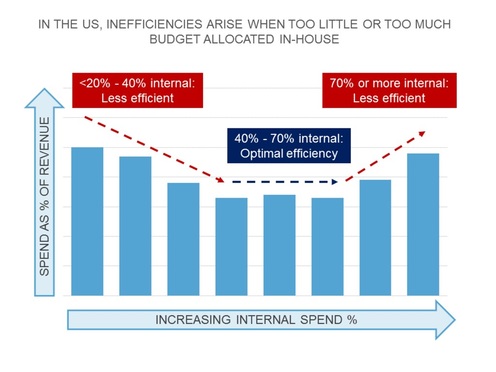Most In-House Law Departments Spend 'Inefficiently,' Study Says
The study from Acritas Research specified an ideal range for internal legal spend as a proportion of total spend.
November 08, 2017 at 03:19 PM
5 minute read
 Acritas legal spend chart. Courtesy of Acritas.
Acritas legal spend chart. Courtesy of Acritas. Six out of 10 in-house law departments allocate their legal spend inefficiently, according to a new study from the global legal researcher Acritas Research.
U.S. companies should allocate 40 percent to 70 percent of their legal spend internally, the study recommended—or else run the risk of not being able to optimize their dollars.
The figures come from Acritas' annual Sharplegal study, for which it conducts over 2,000 interviews with senior in-house counsel in large organizations around the world each year.
Lisa Hart Shepherd, CEO of U.K.-based Acritas, said in an interview Wednesday, “It was interesting to note how economies of scale came into play in terms of the internal team size required to service different sized organizations.”
Hart Shepherd said legal departments with less than $200 million in revenue had more than 10 times the number of lawyers per $100 million of revenue than larger departments with more than $20 billion in revenue. “And yet the average balance of budget allocated internally didn't really change by size,” she added.
She cautioned, though, that the pattern of law department spending can differ by country and industry sector. The study said in higher spending countries, it appears keeping too much budget in-house drives inefficiency. The 40 to 70 percent optimal range applies specifically to U.S. companies.
“Russian companies, for example, have far lower external spend and much bigger in-house teams,” Hart Shepherd explained. “So it's important to find a relevant peer group benchmark.”
The report showed that, on average, organizations reported 0.4 lawyers per $100 million of revenue. This varied according to company size, with the smallest companies in the study (revenue $50 to $500 million) having 0.9 lawyers per $100 million of revenue, and the largest companies (revenue $6 billion-plus) having 0.2 lawyers per $100 million of revenue.
Hart Shepherd said she was surprised by the relatively small number of lawyers most organizations have. “On average, a $1 billion company has four in-house lawyers,” she said. “Surely there must be benefits to having a larger team for many organizations, both from a cost perspective and ensuring advice is integrated into the business.”
She said the trend is for in-house legal teams to spend more internally. “We have seen the internal spend grow in recent years, and it's increased by 11 percent since we first measured it in 2012,” Hart Shepherd said.
In a related study the research firm reported in May that companies in the United States spend 166 percent more on legal services per dollar of revenue compared to companies in other parts of the world.
 Acritas legal spend chart. Courtesy of Acritas.
Acritas legal spend chart. Courtesy of Acritas. Six out of 10
U.S. companies should allocate 40 percent to 70 percent of their legal spend internally, the study recommended—or else run the risk of not being able to optimize their dollars.
The figures come from Acritas' annual Sharplegal study, for which it conducts over 2,000 interviews with senior in-house counsel in large organizations around the world each year.
Lisa Hart Shepherd, CEO of U.K.-based Acritas, said in an interview Wednesday, “It was interesting to note how economies of scale came into play in terms of the internal team size required to service different sized organizations.”
Hart Shepherd said legal departments with less than $200 million in revenue had more than 10 times the number of lawyers per $100 million of revenue than larger departments with more than $20 billion in revenue. “And yet the average balance of budget allocated internally didn't really change by size,” she added.
She cautioned, though, that the pattern of law department spending can differ by country and industry sector. The study said in higher spending countries, it appears keeping too much budget in-house drives inefficiency. The 40 to 70 percent optimal range applies specifically to U.S. companies.
“Russian companies, for example, have far lower external spend and much bigger in-house teams,” Hart Shepherd explained. “So it's important to find a relevant peer group benchmark.”
The report showed that, on average, organizations reported 0.4 lawyers per $100 million of revenue. This varied according to company size, with the smallest companies in the study (revenue $50 to $500 million) having 0.9 lawyers per $100 million of revenue, and the largest companies (revenue $6 billion-plus) having 0.2 lawyers per $100 million of revenue.
Hart Shepherd said she was surprised by the relatively small number of lawyers most organizations have. “On average, a $1 billion company has four in-house lawyers,” she said. “Surely there must be benefits to having a larger team for many organizations, both from a cost perspective and ensuring advice is integrated into the business.”
She said the trend is for in-house legal teams to spend more internally. “We have seen the internal spend grow in recent years, and it's increased by 11 percent since we first measured it in 2012,” Hart Shepherd said.
In a related study the research firm reported in May that companies in the United States spend 166 percent more on legal services per dollar of revenue compared to companies in other parts of the world.
This content has been archived. It is available through our partners, LexisNexis® and Bloomberg Law.
To view this content, please continue to their sites.
Not a Lexis Subscriber?
Subscribe Now
Not a Bloomberg Law Subscriber?
Subscribe Now
NOT FOR REPRINT
© 2025 ALM Global, LLC, All Rights Reserved. Request academic re-use from www.copyright.com. All other uses, submit a request to [email protected]. For more information visit Asset & Logo Licensing.
You Might Like
View All
Chasing Goals Won't Give Frazzled In-House Lawyers Inner Peace, But a 'Mental Cleanse' Might

With 'Fractional' C-Suite Advisers, Midsize Firms Balance Expertise With Expense
4 minute read
Some Clients Are Pushing for Transparency Surrounding Origination Credits
5 minute read
The AI Revolution Is Here. Who Will Be the Winners and Losers in Legal Services?
10 minute readTrending Stories
- 1Thursday Newspaper
- 2Public Notices/Calendars
- 3Judicial Ethics Opinion 24-117
- 4Rejuvenation of a Sharp Employer Non-Compete Tool: Delaware Supreme Court Reinvigorates the Employee Choice Doctrine
- 5Mastering Litigation in New York’s Commercial Division Part V, Leave It to the Experts: Expert Discovery in the New York Commercial Division
Who Got The Work
J. Brugh Lower of Gibbons has entered an appearance for industrial equipment supplier Devco Corporation in a pending trademark infringement lawsuit. The suit, accusing the defendant of selling knock-off Graco products, was filed Dec. 18 in New Jersey District Court by Rivkin Radler on behalf of Graco Inc. and Graco Minnesota. The case, assigned to U.S. District Judge Zahid N. Quraishi, is 3:24-cv-11294, Graco Inc. et al v. Devco Corporation.
Who Got The Work
Rebecca Maller-Stein and Kent A. Yalowitz of Arnold & Porter Kaye Scholer have entered their appearances for Hanaco Venture Capital and its executives, Lior Prosor and David Frankel, in a pending securities lawsuit. The action, filed on Dec. 24 in New York Southern District Court by Zell, Aron & Co. on behalf of Goldeneye Advisors, accuses the defendants of negligently and fraudulently managing the plaintiff's $1 million investment. The case, assigned to U.S. District Judge Vernon S. Broderick, is 1:24-cv-09918, Goldeneye Advisors, LLC v. Hanaco Venture Capital, Ltd. et al.
Who Got The Work
Attorneys from A&O Shearman has stepped in as defense counsel for Toronto-Dominion Bank and other defendants in a pending securities class action. The suit, filed Dec. 11 in New York Southern District Court by Bleichmar Fonti & Auld, accuses the defendants of concealing the bank's 'pervasive' deficiencies in regards to its compliance with the Bank Secrecy Act and the quality of its anti-money laundering controls. The case, assigned to U.S. District Judge Arun Subramanian, is 1:24-cv-09445, Gonzalez v. The Toronto-Dominion Bank et al.
Who Got The Work
Crown Castle International, a Pennsylvania company providing shared communications infrastructure, has turned to Luke D. Wolf of Gordon Rees Scully Mansukhani to fend off a pending breach-of-contract lawsuit. The court action, filed Nov. 25 in Michigan Eastern District Court by Hooper Hathaway PC on behalf of The Town Residences LLC, accuses Crown Castle of failing to transfer approximately $30,000 in utility payments from T-Mobile in breach of a roof-top lease and assignment agreement. The case, assigned to U.S. District Judge Susan K. Declercq, is 2:24-cv-13131, The Town Residences LLC v. T-Mobile US, Inc. et al.
Who Got The Work
Wilfred P. Coronato and Daniel M. Schwartz of McCarter & English have stepped in as defense counsel to Electrolux Home Products Inc. in a pending product liability lawsuit. The court action, filed Nov. 26 in New York Eastern District Court by Poulos Lopiccolo PC and Nagel Rice LLP on behalf of David Stern, alleges that the defendant's refrigerators’ drawers and shelving repeatedly break and fall apart within months after purchase. The case, assigned to U.S. District Judge Joan M. Azrack, is 2:24-cv-08204, Stern v. Electrolux Home Products, Inc.
Featured Firms
Law Offices of Gary Martin Hays & Associates, P.C.
(470) 294-1674
Law Offices of Mark E. Salomone
(857) 444-6468
Smith & Hassler
(713) 739-1250






